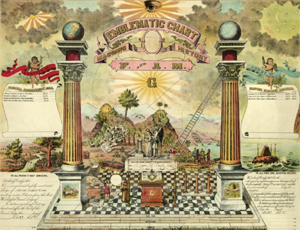About Freemasonry
Freemasonry is the oldest and largest world wide fraternity dedicated to the Brotherhood of Man under the Fatherhood of a Supreme Being. Although of a religious nature, Freemasonry is not a religion. It urges its members, however, to be faithful and devoted to their own religious beliefs. Masonry takes good men and makes them better through fraternity, integrity, and trust.
Freemasonry is not a building, but a brotherhood -- therefore it is the Brothers who define the fraternity.
 George Washington, James Monroe, Franklin D Roosevelt, Theodore Roosevelt, and ten other US Presidents were Masons.
George Washington, James Monroe, Franklin D Roosevelt, Theodore Roosevelt, and ten other US Presidents were Masons.
Thirty-five supreme court justices, including Chief Justice John Marshall were Masons.
Brothers Benjamin Franklin and John Hancock signed the Declaration of Independence; eleven years later Franklin and 12 other Brothers signed the United States Constitution.
Masonic symbols made by the silversmith and patriot Paul Revere are still used in his lodge.
Ty Cobb and Arnold Palmer. Robert Burns, Sir Arthur Conan Doyle, and Samuel Clemens (Mark Twain). Clark Gable and John Wayne. Neil Armstrong, Buzz Aldrin and John Glenn.
If a few of these names sound familiar, they should. Freemasonry built the solid foundation upon which our civilization has flourished. Through large and small beneficent acts, it is our responsibility to continue the work these men began -- to build on their achievements locally in our communities and abroad in the world.
 Historically, Freemasonry traces its roots to the guilds of operative stonemasons who built cathedrals, castles, and temples -- allegorically even the very temple of King Solomon.
Historically, Freemasonry traces its roots to the guilds of operative stonemasons who built cathedrals, castles, and temples -- allegorically even the very temple of King Solomon.
As cathedral building declined in the 17th century, philosophers, thinkers, and leaders were accepted into the guilds as speculative Masons. They joined in part out of respect for the mechanics and ideals of the guild, and in time these speculative Masons developed democratic processes that are today reflected across governments and societies worldwide. Speculative Masonic lodges adopted the tools and history of stonemasons as symbols and allegories to guide man's behavior.
In 1717, four such lodges, which had been meeting regularly in London, united to form the first Grand Lodge of England under the direction of a Grand Master. From that first Grand Lodge, Freemasonry has spread throughout the world. Today, some 150 Grand Lodges have a total membership of approximately four million Masons.
Is Freemasonry a religion?
Freemasonry is neither a religion, nor does it require a religious affiliation. Masons worship in congregations of their choice. Some are ordained priests, ministers, or rabbis; many serve in lay capacities; and others have no affiliation. With origins in post-Reformation England, Freemasonry's allegories and rituals are rooted in Judeo-Christian tradition. They exemplify mankind's universal experience and inculcate an admired moral and ethical value system. With respect to religion, Freemasonry simply teaches the "Fatherhood of God" and the "Brotherhood of Man."
Is Freemasonry a "secret" society?
No. Freemasonry is a fraternity of men who are proud to be known as Masons. Since our inception, the world has known of speculative Freemasonry and its work. Thousands of works discussing Masonic history, traditions, craft, and proceedings are widely available to the public.
Although it is not a secret society, Freemasonry is a society with secrets, all extending from historic tradition. Our modes of recognition, ceremonies, and rituals of conferring the Degrees of Masonry are among our fraternity's secrets.
The Grand Lodge of New York has a more extensive set of answers to common questions, such as:
-
If Masonry started in Great Britain, how did it get to America?
What's a lodge?
What's a degree?
What is a Masonic Bible?
Why does Masonry use symbols?
What does Masonry teach?
Content on this page borrowed from the Grand Lodge of New York and Grand Lodge of Ontario, Canada.